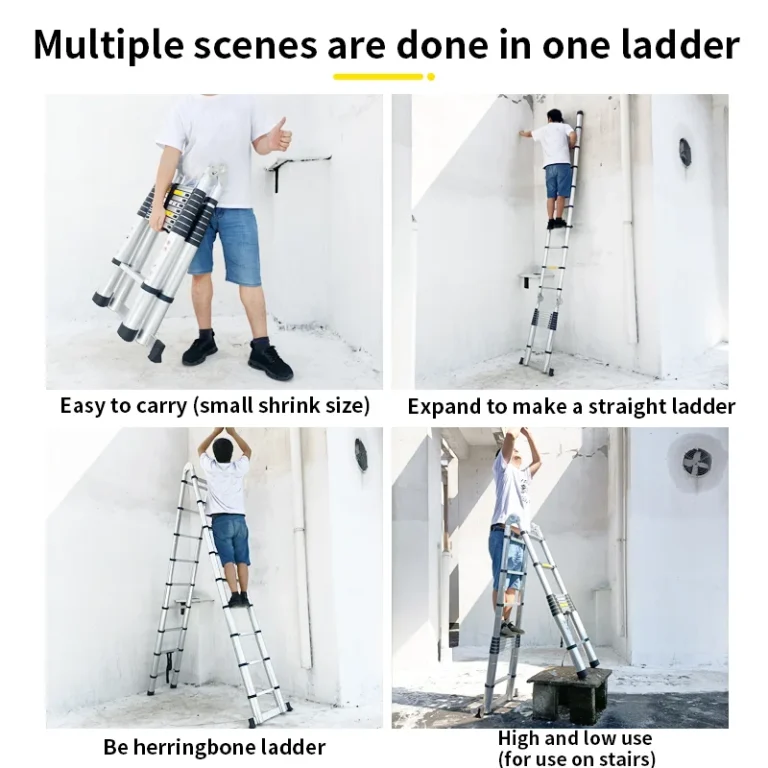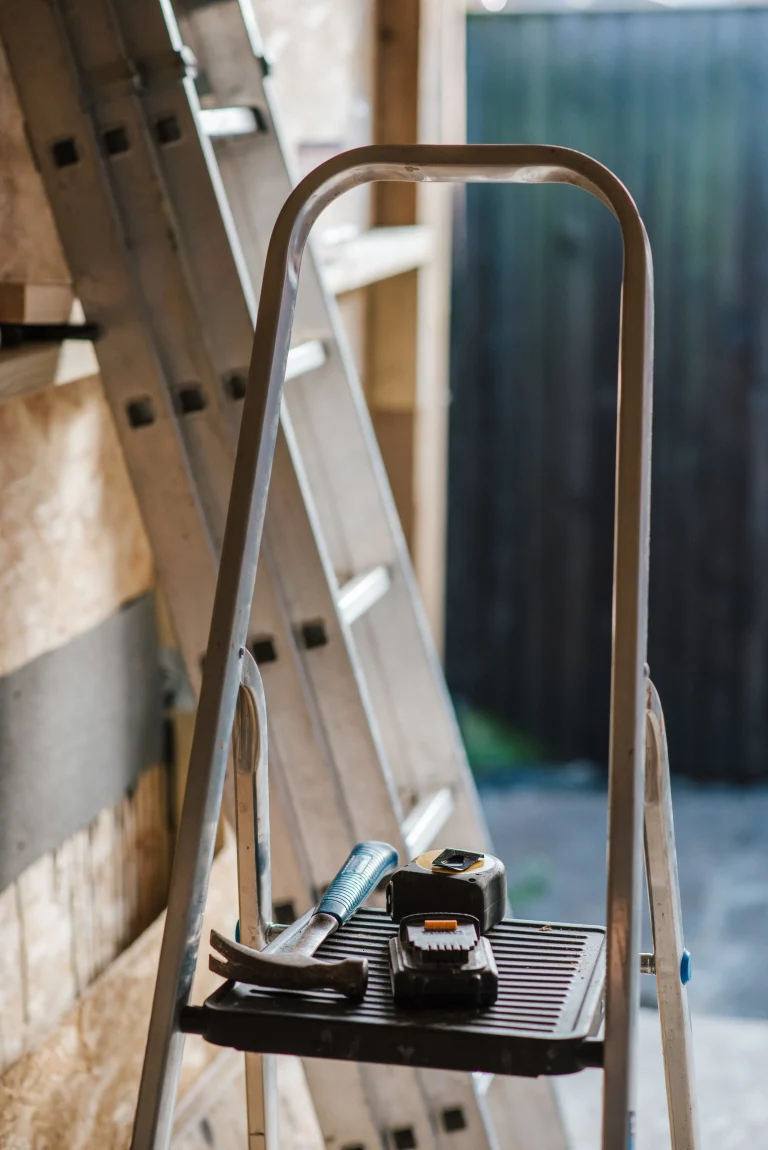Ladders look like no big deal, but they cause tons of accidents at home. You might think climbing a ladder in your house is way safer than at a construction site. Nope, that’s not true! This article dives into why ladder mishaps happen so often at home. We’ll check out the top reasons people get hurt, how home ladder use is different from work sites, and how to stay safe. Plus, we’ll show how JADDUO’s ladders can make your home jobs easier and safer.
What Are the Leading Causes of Injuries When Using Ladders at Home?
You’d think using a ladder at home is easy-peasy. But in China, over 10,000 folks get banged up or worse every year from ladder accidents. A crazy 1 in 4 deadly falls involves a ladder! Over half of these messes happen because people use ladders wrong. Here’s what they do:
- Set the ladder on shaky or bumpy ground.
- Lean way too far while working.
- Skip checking the ladder before climbing.
- Stand on the top steps, which is super risky.
At home, there’s no boss yelling about safety rules like at work. This makes people feel too cozy, so they skip easy stuff like making sure the ladder’s locks are tight or putting on shoes with good grip.
How Do Hazards Differ Between Domestic and Industrial Ladder Use?
At home, you might grab a ladder on a whim to swap a light bulb or hang Christmas lights. At work, people are trained and stick to strict safety rules. They look for cracks, worn-out feet, or missing bits before climbing. They also know the ladder’s weight limit. At home, you might not even know how much your ladder can hold!
Homes have sneaky traps, too. Picture slippery bathroom tiles, lumpy yard dirt, or cluttered garages. These make ladders slip or tip over way faster than at a work site.
Why Do People Underestimate Ladder Risks at Home?
When you’re chilling at home, you feel super safe. It’s your place, so you think, “It’s just a quick fix!” That mindset leads to dumb moves, like climbing barefoot or stretching way out to one side. Since there’s no big danger sign flashing, it’s easy to forget basic safety stuff.
What Rules Should You Follow When Using a Ladder at Home?
Which Safety Guidelines Are a Must for Home Ladder Use?
Before you hop on a ladder at home, do these things:
- Check It Out: Look at bolts, hinges, and locks. Make sure they’re snug. Wipe off mud or grease from steps and feet. Wear shoes with awesome grip—no slick soles!
- While Climbing: Face the ladder. Keep three points of contact, like two hands and one foot. Don’t go over the weight limit, usually about 150kg.
- Weather and Health: Don’t climb outside if it’s super windy. Skip it if you’re wiped out or on meds that mess with your balance.
How Do Stability and Ground Conditions Affect Safety?
The ground under your ladder is a huge deal. Put it on solid, flat ground. For straight ladders, set a 75-degree angle (think 1:4 ratio). Don’t place it on soft dirt or slippery floors without grippy feet. If the ground’s all bumpy, like gravel in a yard, grab a ladder with adjustable stabilizers or balance bars to keep it from wobbling.
When Should You Toss Your Ladder Instead of Fixing It?
If your ladder’s got bent steps, cracked welds, or worn-out rubber feet, it’s time for a new one. Outdoor ladders usually last about a year since rain and sun beat them up. Indoor ones can last up to two years if you take care of them. Don’t try patching a broken ladder with stuff like duct tape—it’s crazy dangerous and makes things worse.
How Can You Incorporate Safer Ladders into Daily Life?
What Makes Some Home Ladders Safer?
Modern ladders have neat features to keep you safe. Think grippy feet, wide steps for solid footing, and locks that stop the ladder from folding up by mistake. The Orange White Step Steel Ladder Family Assistant Portable Folding Ladder from JADDUO is a great pick. Its steel frame and anti-skid design make it super steady for jobs like hanging curtains or cleaning vents.
How Do These Designs Stop Common Accidents?
Lots of falls happen because of bad balance or slick steps. Wide steps with grippy textures spread your weight better and keep you steady. Some ladders have telescopic parts that lock tight at each height, so they don’t fold up out of nowhere. Folding designs make storage a breeze without losing strength, which cuts down on accidents from messy spaces.
Which Ladder Fits Specific Home Jobs?
For easy indoor tasks like putting up pictures or reaching closet shelves, step ladders with wide, grippy steps are the way to go. For outdoor jobs like cleaning gutters, a telescopic straight ladder gives you reach without being clunky. If you want one ladder for both indoor and outdoor stuff, like yard work or room fixes, JADDUO’s aluminum alloy telescopic models are light, tough, and easy to stash.
What Makes Modern Ladders Easier—and Safer—to Use?
How Does Anti-Slip Tech Help with Climbing?
Anti-slip stuff makes ladders way safer. Grippy rubber steps grab onto dirt or dust, so you don’t slip, even on wet or oily floors. Wide steps (up to 78mm) keep your feet comfy during long jobs, spreading pressure so you don’t get tired fast.
Why Are Telescopic and Folding Ladders So Cool?
Telescopic ladders shrink down to under a meter long, so you can tuck them under a bed or in a closet. Folding ones are easy to carry with one hand but still hold up to 150kg. They’re perfect for small apartments where you need a ladder for tons of jobs, like swapping bulbs or reaching a balcony.
Why Match Load Capacity to Who’s Using It?
Most home extension ladders hold 100 to 150 kilograms, enough for one person plus some tools. But if bigger folks or a few people will use it, pick a ladder made from thick aluminum alloy. JADDUO’s models are built to handle heavier loads without trouble.
How Can You Extend Your Ladder’s Lifespan While Keeping It Safe?
Where Should You Stash Your Ladder?
Store your ladder in a dry spot away from sun or rain, which can wreck it over time. Telescopic ladders should be collapsed all the way and tied with straps to stay tidy. Don’t lean them against walls where they could tip over, especially with kids around. Storing them right keeps them safe and looking good.
How Often Should You Check Your Ladder—and What to Look For?
Give your ladder a quick check every month. Make sure locks move smoothly. Look at rivets, welds, and rubber feet for wear. Check for cracks in joints. If it sits unused for a while, add a bit of oil to the joints. These easy checks stop problems and can make your ladder last way longer.
Can Training Help Cut Down on Household Ladder Accidents?
How Can You Teach Family Simple Safety Tricks?
Set a family rule: Before anyone climbs a ladder—even just a couple steps—they gotta check a few things:
- Are all locks snapped in?
- Is the ground solid?
- Am I wearing grippy shoes?
- Is someone nearby if I need a hand?
Write this list down and stick it where you keep the ladder. It’s a simple way to put safety first at home.
Why Use a Checklist Every Time?
A quick checklist catches stuff you might miss, like loose bolts or wet steps. Even tiny slip-ups can cause big injuries, even from just a meter off the ground. Making this a habit, especially for kids, builds a safety vibe that goes beyond ladders.
Is There a Way to Work Faster Without Losing Safety at Home?
Which Jobs Get Easier with Smart Ladders?
Whether you’re painting walls, hanging holiday lights, or trimming trees, modern multi-position ladders make things quicker and safer. JADDUO’s ladders have grippy feet, so they stay steady even on uneven ground like lawns or driveways.
How Does Smart Design Save Time?
Neat designs mean fewer trips up and down. You can set tools on top trays. Solid footing means less fussing mid-job. Switching between A-frame and straight ladder modes is super quick, so you can zip from one task to another. Folding ladders store easily without losing strength, so you spend less time setting up and more time getting stuff done.
FAQs
Q1. Can I Use My Indoor Step Ladder Outside for a Bit?
A: Yes, but only on dry, solid ground. Don’t leave it out too long—indoor ladders might not have coatings to handle weather.
Q2. What’s Safer: Aluminum Alloy or Stainless Steel Ladders?
A: Aluminum alloy ladders are lighter and don’t rust, so they’re awesome for home use. Stainless steel ones are heavier and better for fixed spots.
Q3. Can My Kid Use Our Folding Step Ladder?
A: Only with an adult nearby. Make sure they know not to stand on the top step and to set the ladder on flat ground with locks snapped in.











